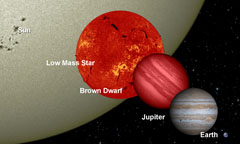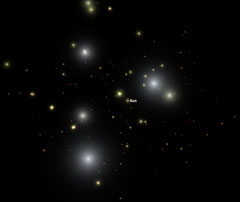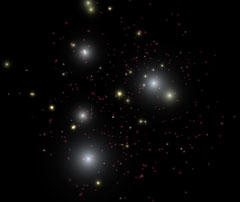 |
|
(NASA's Wide-field Infrared Survey Explorer, or WISE, will uncover many "failed" stars, or brown dwarfs, in infrared light. This diagram shows a brown dwarf in relation to Earth, Jupiter, a low-mass star and the sun.
Stars with less mass than the sun are smaller and cooler, and hence much fainter in visible light. Brown dwarfs are the smallest and coolest of stars. They have less than eight percent of the mass of the sun, which is not enough to sustain the fusion reaction that keeps the sun hot. These cool orbs are nearly impossible to see in visible light, but stand out when viewed in infrared. Their diameters are about the same as Jupiter's, but they can have up to 80 times more mass and are thought to have planetary systems of their own.
(Image: NASA)
Sizes:
small (27K) 240 x 144 JPEG
medium (92K) 800 x 479 JPEG
large (806K) 1663 x 995 JPEG
|

 |
|
Astronomers think there are roughly as many brown dwarfs as regular stars like our sun, but brown dwarfs are often too cool to find using visible light. These tiny orbs are similar to stars but they are cooler and less massive. They lack the mass to fuse atoms at their cores and shine with starlight. Using infrared light, NASA's Wide-field Infrared Survey Explorer (WISE), will find many dozens of brown dwarfs within 25 light years of the sun.
These two pictures show simulated data before and after the WISE mission (stars are not real). The simulated picture on top shows known stars (white and yellow) and brown dwarfs (red) in our solar neighborhood. The picture on the bottom shows additional brown dwarfs WISE is expected to find. One of these newfound brown dwarfs could even be closer to us than our closest known star, Proxima Centauri, which is four light-years away.
(Photo: NASA/JPL-Caltech)
Sizes: (Top)
small (20K) 240 x 202 JPEG
medium (32K) 600 x 505 JPEG
large (178K) 1210 x 1018 JPEG
Sizes: (Bottom)
small (37K) 240 x 202 JPEG
medium (44K) 600 x 505 JPEG
large (222K) 1210 x 1018 JPEG
|







